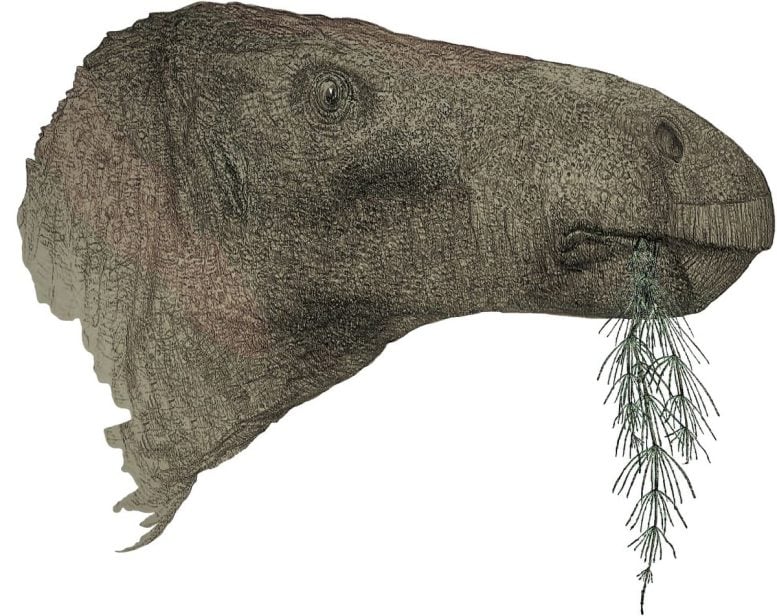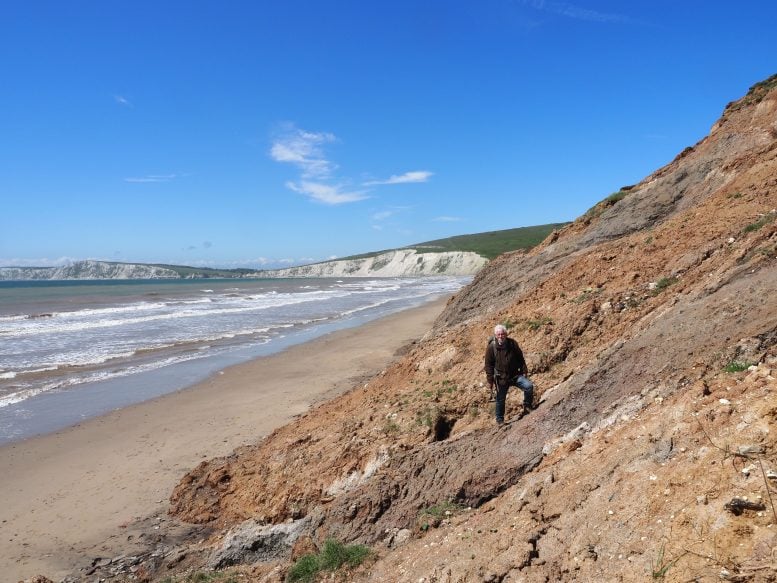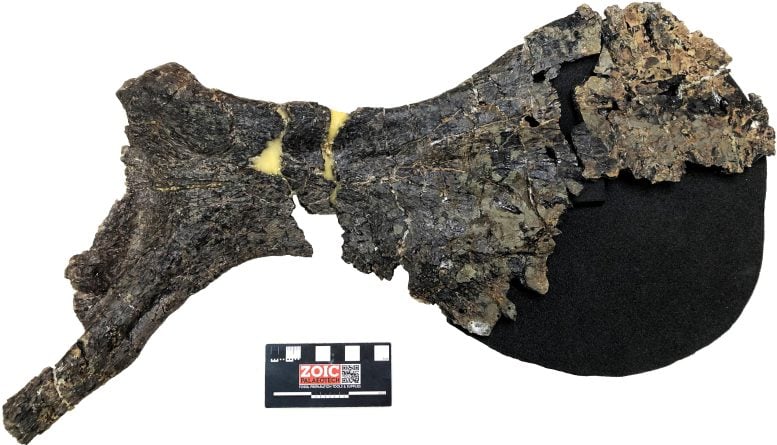
An artistic representation of the dinosaur. Credit: John Sibbick
A new dinosaur
” data-gt-translate-attributes=”({“attribute”:”data-cmtooltip”, “format”:”html”})” tabindex=”0″ role=”link”>speciesComptonatus chasei, discovered on the Isle of Wight, represents a major advance in understanding
” data-gt-translate-attributes=”({“attribute”:”data-cmtooltip”, “format”:”html”})” tabindex=”0″ role=”link”>CretaceousDiversity of modern-day dinosaurs in England, with ongoing research suggesting larger finds are likely.
A new paper describes the most complete dinosaur discovered in the United States in the last century. The specimen, estimated to be about 125 million years old and with a pubic bone the size of a dinner plate, was found in 2013 in the cliffs of Compton Bay on the Isle of Wight. The discovery was made by fossil collector Nick Chase before he tragically died of cancer.
Jeremy Lockwood, retired GP and
” data-gt-translate-attributes=”({“attribute”:”data-cmtooltip”, “format”:”html”})” tabindex=”0″ role=”link”>University of Portsmouth A PhD student, he helped excavate the dinosaur and spent years analyzing the 149 different bones that made up the skeleton. Jeremy determined that the skeleton represented a new genus and species, which he named Comptonatus chasei in tribute to Nick.
Jeremy said: “Nick had a phenomenal nose for finding dinosaur bones – he was truly a modern-day Mary Anning. He collected fossils every day in all weathers and donated them to museums. I had hoped we would spend our old age collecting together as we were the same age, but sadly that was not to be. Despite his many wonderful discoveries over the years, including the most complete Iguanodon “The only skull ever found in Britain is the first dinosaur to bear his name.”
Scientific knowledge and theories
When it was first discovered, the specimen was thought to be a known dinosaur called MantellisaurusBut Jeremy’s study revealed a much greater diversity of dinosaurs. In fact, this is the second new genus Jeremy has described.
He said: “I was able to show that this dinosaur is different because of some unique features of its skull, teeth and other parts of its body. For example, its lower jaw has a straight lower edge, whereas most iguanodonts have a jaw that curves downward. It also has a very wide pubic hip bone, which is much larger than that of other similar dinosaurs. It’s like a dinner plate!”

Jeremy Lockwood at the Compton Bay excavation site, Isle of Wight. Credit: University of Portsmouth
Jeremy isn’t sure why the pubic hip bone, which sits at the base of the abdomen, was so large: “It probably served as a muscle attachment point, which could mean that its mode of locomotion was a little different, or that it served to support the contents of the stomach more effectively, or even that it was involved in how the animal breathed, but all of these theories are somewhat speculative.”
Jeremy named the dinosaur Comptonatus after Compton Bay where it was found and ‘tonatus’ is a Latin word meaning ‘thunderous’.
“This animal must have weighed about a ton, about the size of a large male American bison. And fossilized footprints found nearby show that it was probably a gregarious animal. So it’s possible that large herds of these lumbering dinosaurs could have moved across floodplains more than 120 million years ago if they were scared off by predators.”
Contributions to research and inclusion in museums
Dr Susannah Maidment, Senior Research Fellow and Palaeontologist at the Natural History Museum and lead author of the paper written while supervising Jeremy’s PhD, commented: “Comptonatus is a fantastic dinosaur specimen: one of the most complete discovered in the UK in a century.
“Its recognition as a new species is due to the incredibly detailed work of NHM Scientific Associate Dr Jeremy Lockwood, whose research continues to reveal that dinosaur diversity in southern England in the Early Cretaceous was far greater than previously thought.
“The specimen, which is younger than Brightstoneus but older than Mantellisaurus (two iguandontian dinosaurs closely related to Comptonatus) demonstrates rapid rates of evolution in iguandontian dinosaurs during this period, and may help us understand how ecosystems recovered after a putative extinction event at the end of the
” data-gt-translate-attributes=”({“attribute”:”data-cmtooltip”, “format”:”html”})” tabindex=”0″ role=”link”>Jurassic Period.”

The hip bone ‘in a plate’. Credit: University of Portsmouth
Although only four new species of dinosaur were described from the Isle of Wight during the 1900s, eight new species have been named in the last five years.
Jeremy added: “This is a truly remarkable discovery. It helps us to better understand the different types of dinosaurs that lived in England in the Early Cretaceous period. It adds to recent research that shows that Wessex was one of the most diverse ecosystems in the world.”
The dinosaur has been added to the collections of the Dinosaur Isle Museum in Sandown, Isle of Wight. The article was recently published in the Journal of Systematic Paleontology.
Dr Martin Munt, Curator of Dinosaur Isle, said: “Ongoing research into the museum’s collection continues to reveal exciting new discoveries. Many of Nick’s most important finds have remained on the island, a lasting legacy. We can expect many more new types of prehistoric creatures to be discovered in the cliffs and in the island’s collection.”
Mike Greenslade, Chief Executive of the National Trust on the Isle of Wight, said: “This extraordinary discovery at Compton Bay, within the National Trust, highlights the rich natural heritage of the Isle of Wight. The discovery of the most complete dinosaur in the UK for a century not only highlights the palaeontological significance of the island, but also highlights the importance of preserving our landscapes for future generations to explore and learn from. Nick Chase’s remarkable discovery and Jeremy Lockwood’s dedicated research are testament to the incredible history waiting to be discovered here. We are delighted to be part of this continuing journey of discovery and scientific progress.”
Reference: “Comptonatus chasei, a new iguanodontian dinosaur from the Lower Cretaceous Wessex Formation of the Isle of Wight, southern England” by Jeremy AF Lockwood, David M. Martill and Susannah CR Maidment, 9 July 2024, Journal of Systematic Paleontology.
DOI: 10.1080/14772019.2024.2346573